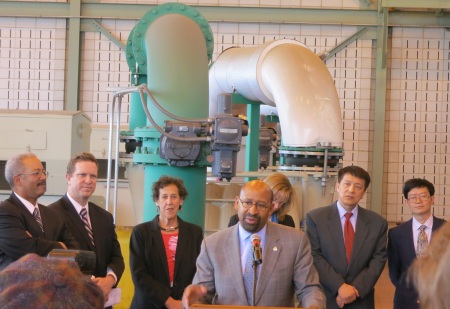Energy Efficiency
|
The Philadelphia Water Department is always searching for ways to improve energy efficiency and contribute to the environmental, social and economic well-being of the city. The goals of PWD's energy initiatives are to:
Looking Ahead: Long-Term Energy Saving Initiatives at PWD
|
Click the markers on the map above to learn more about PWD's alternative energy initatives at our treatment plants. |
|
Solar Energy Generation In April 2011, Philadelphia unveiled its first solar photovoltaic electricity generating system, located at PWD's Southeast Water Pollution Control Plant. The 250-kilowatt solar array consists of more than 1,000 panels covering 60,000 square feet, and its electricity will help power the energy-intensive task of water treatment. The project's total cost of $1.7 million—funded jointly by a Recovery Act Energy Efficiency and Conservation Block Grant and PWD—is expected to have a 9-year payback period. The project helps to achieve Mayor Michael Nutter's Greenworks goal of generating 20 percent of Philadelphia's electricity from alternative energy sources by 2015. |
|

Geothermal Heating In April 2012, a new geothermal project was unveiled at PWD's Southeast Water Pollution Control Plant that uses heat from wastewater (sewage) to warm the facility's buildings. The city partnered with NovaThermal Energy, a Philadelphia-based company, to implement the geothermal heating system. The 1 million BTU/hour unit in the plant's basement can provide heat at approximately 50% of the current cost, which would save $216,000 over the next 15 years. The City of Philadelphia incurred no costs or outlay of expenses for this project, made possible through funding provided by the City of Philadelphia’s Greenworks Pilot Energy Technology Grant program, which is supported by federal Energy Efficiency and Conservation Block Grant funds from the U.S. Department of Energy. Ben Franklin Technology Partners of SE Pennsylvania additionally contributed with a grant to support measurement and verification technical assistance. Fact Sheet: Wastewater Geothermal |
|

Biogas Heating and Biogas Co-generation Biogas is naturally produced at PWD's water pollution control plants when organic matter in sewage breaks down in the absence of oxygen. PWD uses heat from engines along with the biogas generated as a fuel to heat buildings and keep treatment plant digesters at constant temperatures. Biogas co-generation supplies 15% of the utility's total electricity consumption. At the Northeast Water Pollution Control Plant in Bridesburg, a $45 million, 5.6 megawatt biogas co-generation facility is under construction. PWD hired Ameresco Inc. to design, build and maintain a biogas-burning co-generation plant at the Northeast facility. It is estimated that the energy produced from the biogas will save $12 million over the course of the 16-year contract. The energy produced through co-generation will cover 85% of the Northeast plant's annual electricity needs. At the Southwest Water Pollution Control Plant, biogas fuels the production of class A biosolids generated from wastewater treatment sludge. |
|